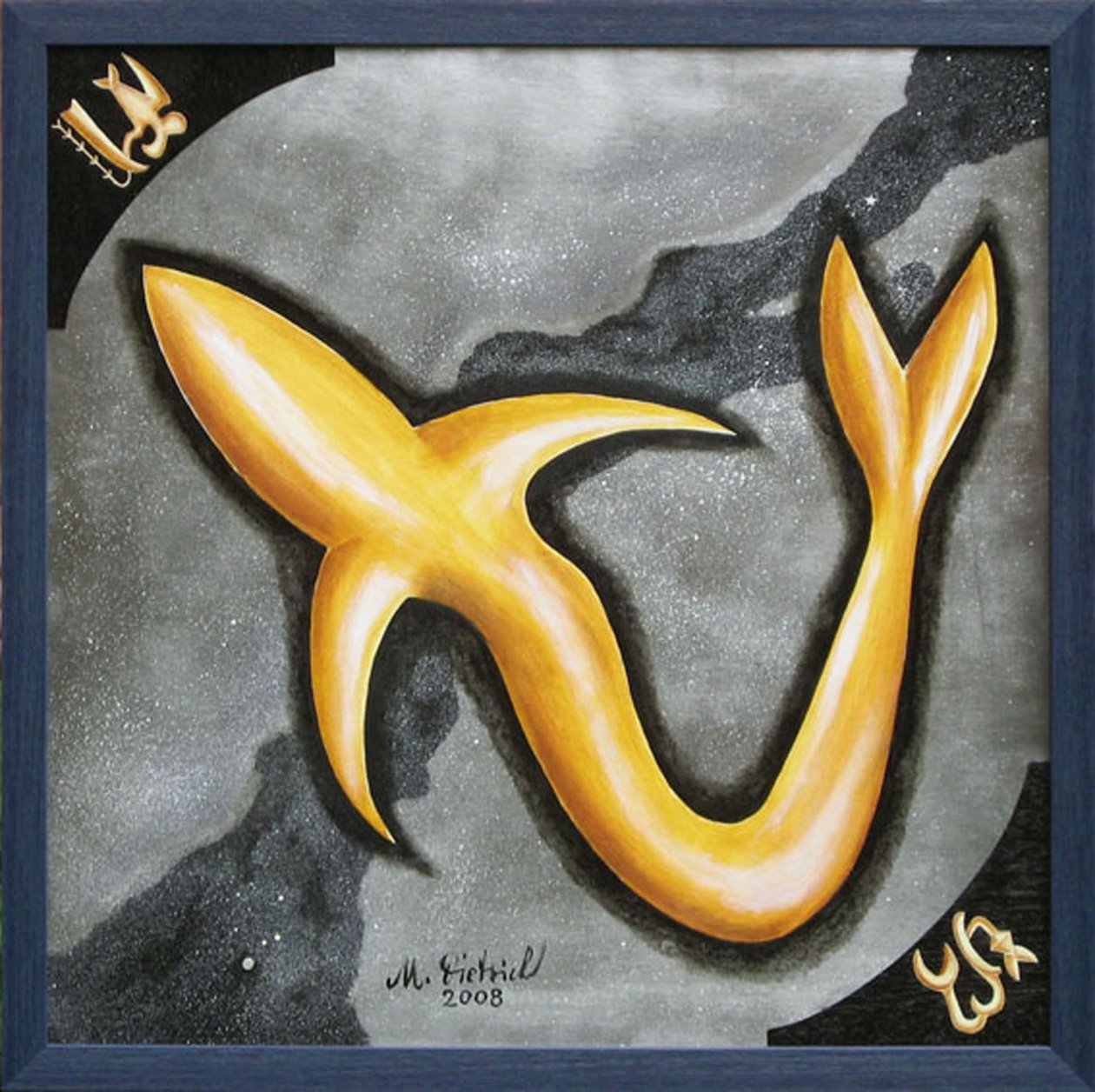2008 · Auf Zinnfolie gemalt, die auf einer kaschierten Leinwand als Träger eine HD-Platte hat
· Picture ID: 858063
Contemporary Arts
No - it's not a shark! But you see such a fish - and I, too, by the way. Still, it's not a shark! I have known it since 1972 and you will only believe me when I make a statement. A mild night with a wonderful crescent moon on the beach at Anakena on Easter Island points to the origin of my knowledge. I stood there alone as a mother soul and imagined what Hoto Matu'a, the forefather of all Easter Islanders, must have felt when he arrived at Easter Island with two double canoes after a six-week crossing. By the way, there is a cave near the beach in which Hoto Matu'a is said to have spent the first few nights. I looked at what I had never seen in my life in the overwhelming, indescribable beauty: the starry night sky over the southern hemisphere of our earth! No light pollution, but stars that I had never seen as a "northern hemisphere". I stood alone on the beach and kept looking up at the sky - then suddenly I felt like I wasn't alone in the place. So I looked down at the earth again and turned around. In fact, I saw a figure about ten meters away. But since this person stood so that he had the moonlight behind him, but I had to look into the bright light of the crescent, I could not see who was standing there. The stranger spoke to me first. There followed a conversation with chunks of English, with hands and feet, with all kinds of gestures and incomprehensible words in the local language. So the normal conversation that every person who travels the world and, like me, had only his mother tongue and rudimentary other languages for easy communication. I do not write that down here, but describe the result. When this person spoke to me, it became clear that it was a female voice. She pointed to the Milky Way and explained to me that it wasn't the "milky way" as I thought it was. So far, what I thought of the Milky Way as our galaxy was, according to these Easter Islanders, a "mango roa" - and this is how a "big shark" is called everywhere in Polynesia. She explained to me that when people die, normal people continue to live as a star in the Milky Way. But extraordinary people, with a lot of mana, brave warriors, wise chiefs and all the people whose lives were not normal mortals, appear as a new star in the sky at night. At the time, I didn't believe the old woman. But after reading exactly that in all of my scientific and popular science work, I now know that it is old Polynesian ideas that, based on the causal principle, explain why there are so many stars in the Milky Way and relatively few solitary stars in the sky gives. The symbol in the supposed Easter Island script "Rongorongo" is a masterpiece of Polynesian carving. In Rongorongo, all characters are always the same size. How should the artists differentiate between the sign of an ordinary shark and that of a mango roa, a large shark? With the admirable creativity of the masters, who prove them through their system of pictorial signs, they bent the shark on two signs, but as one, so that it could be recognized as a big shark in its normal swimming position. Now you have no other option but to believe me that a big shark can be seen in my picture, but its element, the water, is missing. The bright band of the Milky Way divides the sky into north and south. The heavenly shark symbolizes the Milky Way. In the supposed Easter Island script, the concept applies: nothing is ever there. A shark is not a shark - believe it or not! Who wants to know more about Rongorongo can be found here: www.rongorongo-script.de
Mango-roa by Michael H. Dietrich. Available as an art print on canvas, photo paper, watercolor board, uncoated paper or Japanese paper.
easter island ·
polynesia ·
writing ·
sign system ·
astrology ·
polynesian astronomy ·
polynesian myths
|
×




.jpg)
.jpg)
.jpg)
_-_(MeisterDrucke-1644069).jpg)
.jpg)
.jpg)
.jpg)
.jpg)
.jpg)
.jpg)
.jpg)
.jpg)
 - (MeisterDrucke-558732).jpg)

.jpg)
_-_(MeisterDrucke-1505296).jpg)
 - (MeisterDrucke-559142).jpg)
 - (MeisterDrucke-563195).jpg)
.jpg)
.jpg)
.jpg)
 - (MeisterDrucke-561831).jpg)
.jpg)
 - (MeisterDrucke-553191).jpg)
.jpg)
_-_(MeisterDrucke-1502144).jpg)
_-_(MeisterDrucke-1171677).jpg)
.jpg)
_-_(MeisterDrucke-1171759).jpg)
.jpg)
.jpg)
.jpg)
.jpg)
.jpg)
.jpg)
.jpg)
.jpg)
.jpg)
.jpg)
.jpg)
.jpg)
.jpg)
.jpg)







